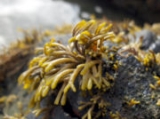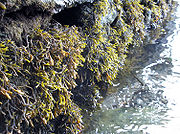
Pelvetia canaliculata
Encyclopedia
Pelvetia canaliculata, channelled wrack, is a very common brown alga
(Phaeophyceae) found on the rocks of the upper shores of Europe
.
layer help prevent the seaweed drying when the tide is out. It is irregularly dichotomously branched with terminal receptacles, and is dark brown in colour. Each branch is of uniform width and without a midrib. The receptacles are forked at the tips.
It is distinguished from other large brown algae by the channels along the frond. It has no mid-rib, no air-vesicules and forms the uppermost zone of algae on the shore growing at or above high water mark. The reproductive organs form swollen, irregularly shaped receptacles at the end of the branches. The conceptacle
s are hermaphrodite
and borne within the receptacles.
 P. canaliculata is the only large algae growing on rocks forming a zone along the upper shore at the upper littoral zone, on the shores of the British Isles. It tolerates a wide range of exposure conditions. It needs periods of exposure to the air, and sometimes grows so high up a beach that coarse grass
P. canaliculata is the only large algae growing on rocks forming a zone along the upper shore at the upper littoral zone, on the shores of the British Isles. It tolerates a wide range of exposure conditions. It needs periods of exposure to the air, and sometimes grows so high up a beach that coarse grass
and other longshore angiosperms grow among it. If it is submerged for more than six hours out of 12 it begins to decay.
to Spain
, including Norway
, Ireland
, Great Britain
, the Netherlands
, France
and Portugal
. In Ireland, collection of Pelvetia canaliculata has been recorded as a source of sustenance during times of famine. A popular Irish folk song, , describes events transpiring between two people who collected the seaweed as a profession.
Brown algae
The Phaeophyceae or brown algae , is a large group of mostly marine multicellular algae, including many seaweeds of colder Northern Hemisphere waters. They play an important role in marine environments, both as food and for the habitats they form...
(Phaeophyceae) found on the rocks of the upper shores of Europe
Europe
Europe is, by convention, one of the world's seven continents. Comprising the westernmost peninsula of Eurasia, Europe is generally 'divided' from Asia to its east by the watershed divides of the Ural and Caucasus Mountains, the Ural River, the Caspian and Black Seas, and the waterways connecting...
.
Description
Pelvetia grows to a maximum length of 15 centimetres (6 in) in dense tufts, the fronds being deeply channelled on one side: the channels and a mucusMucus
In vertebrates, mucus is a slippery secretion produced by, and covering, mucous membranes. Mucous fluid is typically produced from mucous cells found in mucous glands. Mucous cells secrete products that are rich in glycoproteins and water. Mucous fluid may also originate from mixed glands, which...
layer help prevent the seaweed drying when the tide is out. It is irregularly dichotomously branched with terminal receptacles, and is dark brown in colour. Each branch is of uniform width and without a midrib. The receptacles are forked at the tips.
It is distinguished from other large brown algae by the channels along the frond. It has no mid-rib, no air-vesicules and forms the uppermost zone of algae on the shore growing at or above high water mark. The reproductive organs form swollen, irregularly shaped receptacles at the end of the branches. The conceptacle
Conceptacle
Conceptacles are specialised cavities of marine and freshwater algae that contain the reproductive organs. They are situated in the receptacle and open by a small ostiole. Conceptacles are present in Corallinaceae, and Hildenbrandiales, as well as the brown Fucales. In the Fucales there is no...
s are hermaphrodite
Hermaphrodite
In biology, a hermaphrodite is an organism that has reproductive organs normally associated with both male and female sexes.Many taxonomic groups of animals do not have separate sexes. In these groups, hermaphroditism is a normal condition, enabling a form of sexual reproduction in which both...
and borne within the receptacles.
Ecology and distribution

Grass
Grasses, or more technically graminoids, are monocotyledonous, usually herbaceous plants with narrow leaves growing from the base. They include the "true grasses", of the Poaceae family, as well as the sedges and the rushes . The true grasses include cereals, bamboo and the grasses of lawns ...
and other longshore angiosperms grow among it. If it is submerged for more than six hours out of 12 it begins to decay.
Distribution
Pelvetia canaliculata is common on the Atlantic shores of Europe from IcelandIceland
Iceland , described as the Republic of Iceland, is a Nordic and European island country in the North Atlantic Ocean, on the Mid-Atlantic Ridge. Iceland also refers to the main island of the country, which contains almost all the population and almost all the land area. The country has a population...
to Spain
Spain
Spain , officially the Kingdom of Spain languages]] under the European Charter for Regional or Minority Languages. In each of these, Spain's official name is as follows:;;;;;;), is a country and member state of the European Union located in southwestern Europe on the Iberian Peninsula...
, including Norway
Norway
Norway , officially the Kingdom of Norway, is a Nordic unitary constitutional monarchy whose territory comprises the western portion of the Scandinavian Peninsula, Jan Mayen, and the Arctic archipelago of Svalbard and Bouvet Island. Norway has a total area of and a population of about 4.9 million...
, Ireland
Ireland
Ireland is an island to the northwest of continental Europe. It is the third-largest island in Europe and the twentieth-largest island on Earth...
, Great Britain
Great Britain
Great Britain or Britain is an island situated to the northwest of Continental Europe. It is the ninth largest island in the world, and the largest European island, as well as the largest of the British Isles...
, the Netherlands
Netherlands
The Netherlands is a constituent country of the Kingdom of the Netherlands, located mainly in North-West Europe and with several islands in the Caribbean. Mainland Netherlands borders the North Sea to the north and west, Belgium to the south, and Germany to the east, and shares maritime borders...
, France
France
The French Republic , The French Republic , The French Republic , (commonly known as France , is a unitary semi-presidential republic in Western Europe with several overseas territories and islands located on other continents and in the Indian, Pacific, and Atlantic oceans. Metropolitan France...
and Portugal
Portugal
Portugal , officially the Portuguese Republic is a country situated in southwestern Europe on the Iberian Peninsula. Portugal is the westernmost country of Europe, and is bordered by the Atlantic Ocean to the West and South and by Spain to the North and East. The Atlantic archipelagos of the...
. In Ireland, collection of Pelvetia canaliculata has been recorded as a source of sustenance during times of famine. A popular Irish folk song, , describes events transpiring between two people who collected the seaweed as a profession.

